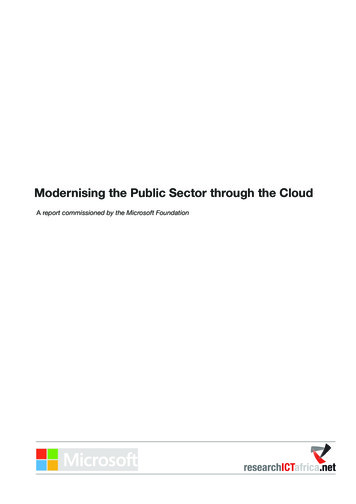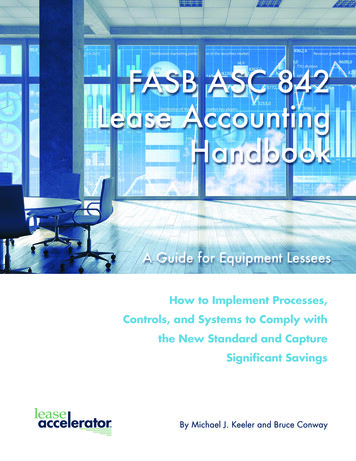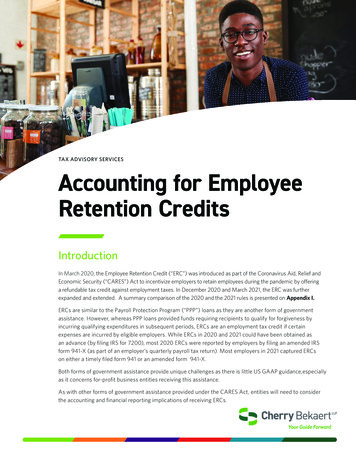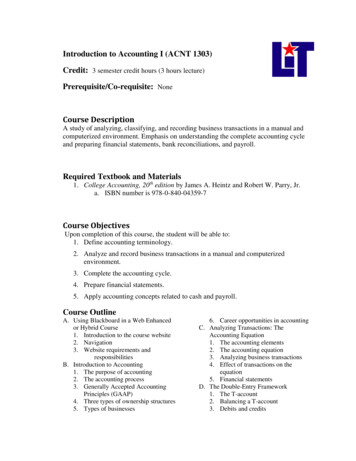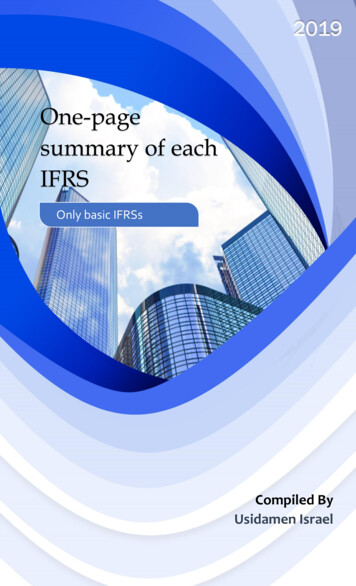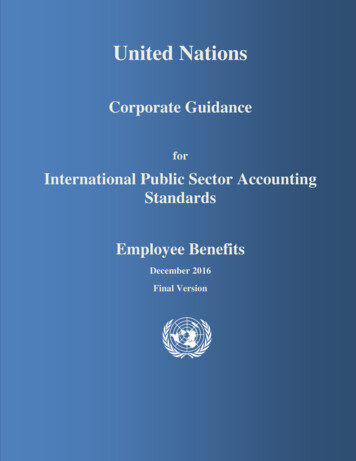
Transcription
UN IPSAS Corporate Guidance – Employee BenefitsContent tableUnited NationsCorporate GuidanceforInternational Public Sector AccountingStandardsEmployee BenefitsDecember 2016Final VersionUN IPSAS Implementation ProjectOPPBA, DMPage 1 of 88
UN IPSAS Corporate Guidance – Employee BenefitsContent tableContent table1Introduction. 62Definitions . 133Classification of United Nations employee benefits . 163.1Employee benefit categories . 163.1.1Short-term benefits . 183.1.2Post-employment benefits . 193.1.2.1Pension benefits provided by the United Nations . 203.1.3Other long-term employee benefits. 203.1.4Termination benefits . 214Recognition and measurement of short-term benefits. 224.1Statement of financial performance . 224.2Statement of financial position . 225Recognition and measurement of post-employment benefits . 255.1Post-employment defined benefit schemes . 255.1.15.1.1.1Present value of defined benefit obligation . 255.1.1.2Fair value of plan assets . 275.1.1.3Accounting for benefit payments . 285.1.2Statement of financial performance . 295.1.2.1Current service costs. 315.1.2.2Interest costs. 315.1.2.3Past service costs . 315.1.2.4The effect of any curtailments and settlements. 315.1.35.2Statement of financial position . 25STATEMENT OF CHANGES IN NET ASSETS . 32Post-employment defined contribution schemes . 335.2.1Statement of financial performance . 335.2.2Statement of financial position . 33UN IPSAS Implementation ProjectOPPBA, DMPage 2 of 88
UN IPSAS Corporate Guidance – Employee Benefits6Content tableRecognition and measurement of other long-term benefits . 346.1Statement of financial position . 346.2Statement of financial performance . 357Recognition and measurement of termination benefits . 377.1Identification of termination event. 377.2Statement of financial position . 377.3Statement of financial performance . 388Specific topics . 398.1Self-insured health insurance. 398.1.1Background: Accounting for self-insurance funds. 408.1.2United Nations self-insured health insurance plan details . 418.1.3Accounting for United Nations self-insured health insurance . 438.28.1.3.1Accounting for monthly employer contributions to self-insured health insurance . 438.1.3.2Accounting for United Nations wide liability from self-insurance health insurance . 458.1.3.3Accounting for contributions by participating organizations . 47Life insurance . 488.2.1United Nations life insurance plan details . 488.2.2Accounting for life insurance . 488.38.2.2.1Accounting for employee contributions to the life insurance scheme . 488.2.2.2Accounting for benefits provided by United Nations and consideration of system-wideliability . 498.2.2.3Accounting for contributions by member organizations . 50Commercial insurance (Malicious Act Insurance Plan (MAIP)) . 508.3.1United Nations MAIP plan details. 508.3.2Accounting for commercial insurance . 518.48.3.2.1Accounting for premiums for own employees . 518.3.2.2Accounting for premiums received from member organizations . 518.3.2.3Accounting for deductible . 52Appendix D - workers compensation scheme . 53UN IPSAS Implementation ProjectOPPBA, DMPage 3 of 88
UN IPSAS Corporate Guidance – Employee BenefitsContent table8.4.1Appendix D – workers compensation plan details . 538.4.2Accounting for workers’ compensation . 558.4.2.1Accounting for benefits provided and consideration of system-wide liability. 558.4.2.2Accounting for benefit payments . 578.4.2.3Accounting for contributions by member organizations . 578.5Recognition of proportionate liability in financial statements of participating organizations . 588.6Choosing the appropriate discount rate . 588.7Cut-off procedures for new and separating employees . 609Presentation considerations . 619.1Short-term benefits . 619.2Post-employment benefits . 619.2.1Post-employment defined benefit schemes . 619.2.2Post-employment defined contribution schemes . 629.3Other long-term benefits . 629.4Termination benefits . 6310Disclosure requirements . 6410.1Short-term benefits . 6410.2Post-employment benefits . 6410.3Defined benefit plans . 6410.4Defined contribution plans (UNJSPF) . 6710.5Other long-term benefits . 6710.6Termination benefits . 6710.7Disclosure requirements for restricted funds . 6810.8Disclosure requirements for participating organizations . 6911Appendices . 7011.1Case study: Employee benefits provided to an employee throughout his life . 7011.1.1Initial travel costs . 7011.1.2Shipping costs . 7111.1.3Assignment grant . 71UN IPSAS Implementation ProjectOPPBA, DMPage 4 of 88
UN IPSAS Corporate Guidance – Employee BenefitsContent table11.1.4Health insurance . 7211.1.5Salary. 7311.1.6Rental subsidy and real estate agent commission . 7411.1.7Education grant. 7511.1.8Post adjustment allowance . 7611.1.9Post-employment benefits . 7711.1.10 Other-long term benefits. 7811.1.11 Employees on secondment . 8011.1.12 Benefit payments upon retirement . 8111.2Case study: self-insured health insurance . 8311.2.1Accounting for monthly contributions by employer . 8311.2.1.1Accounting for monthly contributions by employer for active staff . 8311.2.1.2Accounting for monthly contributions by employer for retired staff . 8411.2.2Accounting for monthly contributions by employee . 8411.2.2.1Accounting for monthly contributions by active employee . 8411.2.2.2Accounting for monthly contributions by retired employee. 8511.2.3Accounting for contributions made by participating organizations . 8511.2.4Accounting for reimbursements to insurance companies . 8511.2.5Accounting for year-end organization wide provision . 86UN IPSAS Implementation ProjectOPPBA, DMPage 5 of 88
UN IPSAS Corporate Guidance – Employee BenefitsIntroduction1 INTRODUCTIONBefore reviewing and assessing how employee benefits should be reflected in the United NationsSecretariat’s (United Nations) financial statements, the question of what qualifies as an employee benefitneeds to be answered.While the different categories of employee benefits are relatively straight forward and explained in section3, they only qualify as employee benefits, if they are provided to employees.One therefore needs to understand what individuals are considered to be employees. This aspect isconsidered to be especially important within the United Nations System as individuals often transferbetween member organizations and are not always legally employed by the organization for which theywork.The most important thing to take note off is that the definition of an employee under IPSAS is much widerthan the United Nations’ definition of staff.As per Staff Rules of United Nations, all individuals whose employment and contractual relationship aredefined by a letter of appointment subject to regulations promulgated by the General Assembly pursuant toArticle 101, Paragraph 1 of the Charter of the United Nations are considered to be staff.For purposes of IPSAS accounting, employees are considered to be individuals providing services to anentity on a full-time, part-time, permanent, casual or temporary basis.Unlike the United Nations’ framework, IPSAS therefore does not focus on the legal aspects ofemployment, but rather focuses on the substance of the arrangement between the individual and theemployer when determining what falls under the term “employee”.Therefore, the United Nations should consider all such individuals as employees and consequently accountfor all their benefits in accordance with IPSAS 25 Employee Benefits, where the organization is exposedto risks consistent with a contract of employment irrelevant of whether there is an actual arrangement inplace or not or whether the employment agreement is provided by another United Nations organization.While this assessment is generally relatively straight forward regarding United Nations staff, the questionbecomes more complex regarding contractors, consultants and similar types of individuals and a thoroughassessment of each of these individuals should therefore be made to assess whether payments made tothese fall under the scope of IPSAS 25 Employee Benefits.UN IPSAS Implementation ProjectOPPBA, DMPage 6 of 88
UN IPSAS Corporate Guidance – Employee BenefitsIntroductionExample – Overview of United Nations’ employeesAn initial assessment of the different types of individuals working for the United Nations has been madeto assess whether payments made to such individuals fall under the scope of IPSAS 25 Employee Benefitsor not.Type of individualStaffStaff transferred inand outIndividualconsultantsAdditional informationAs defined in the charter of the UnitedNationsOn a regular basis, staff is transferredbetween different United Nationsorganizations. The question arises whichorganization should account for them asemployees and consequently should accountfor short-term benefits, other-long termbenefits, post-employment benefits andtermination benefits such individuals areentitled to.Within scope of IPSAS 25?YesYesWhile the expectation would bethat such individuals qualify asemployees, the question is whichorganization should account fortheir benefits. This decisiongenerally depends on thearrangements between thereceiving and releasingorganizations. An example of thisis provided in section 11.1.11.An individual consultant is an individualBased on the information provided,who is a recognized authority or specialist in the expectation is that thesea specific field of study engaged by theindividuals qualify as employeesUnited Nations under a temporary contractunder IPSAS. The United Nationsonly for a specific period to deliver ashould however assess for eachspecific output, as specified in the Terms of individual consultants, whether it isReference, in and advisory or consultativeexposed to risks consistent with acapacity.contract of employment. Generallyfor individual consultants, theoffices have observed that: The contract with theindividual contractor does notgive an indication on theirstatus; Individual consultants getmonthly pay based onsubmission on bill with numberof days worked in a month;UN IPSAS Implementation ProjectOPPBA, DMPage 7 of 88
UN IPSAS Corporate Guidance – Employee BenefitsIntroduction InstitutionalconsultantsContractorInstitutional consultants are consultingcompanies generally hired by theProcurement Division.As the individual consultants supporting theUnited Nations are employed by theconsulting company, they do not fall underthe scope of IPSAS 25 for the purpose of theUnited Nations’ financial statements.An individual contractor is an individualengaged by the organization from time totime under temporary contract for specifiedperiod of time to provide expertise, skills orknowledge, similar to those of staffmembers to meet additional workload or fora temporary vacancy, for the performance ofa specific task or piece of work.UN does not face similar risksas for their staff members.However UN may provideappendix D benefit on accountof moral liability; Individual consultants are insubstance not treated like UNemployees;Performance of Staff members ofUN is reviewed through arobust performance appraisalsystem, however this is notapplicable for individualconsultants.NoBased on the information provided,the expectation is that theseindividuals qualify as employeesunder IPSAS. The United Nationsshould however assess for eachcontractor, whether it is exposed torisks consistent with a contract ofemployment.Generally for contractors theoffices have observed andcommented that: The contract with thecontractors does not give anindication on their status; Contractors get monthly paybased on submission on billUN IPSAS Implementation ProjectOPPBA, DMPage 8 of 88
UN IPSAS Corporate Guidance – Employee BenefitsIntroduction Key managementpersonnelwith number of days worked ina month or completion od adeliverable;UN does not face similar risksas for their staff members.However UN may provideappendix D benefit on accountof moral liability;Contractors are in substancenot treated like UN employees;UN do not performperformance appraisal ofindividual’s work processes.Normally remuneration islinked with deliverables of thecontract.IPSAS 25.7 specifically states that keymanagement personnel fall under the scopeof employee benefits.A definition of key management personnelis included in IPSAS 20 Related PartyDisclosures and is as follows1:Key management personnel are2:(a) All directors or members of thegoverning body of the entity; and(b) Other persons having the authority andresponsibility for planning, directing,and controlling the activities of thereporting entity. Where they meet thisrequirement, key managementpersonnel include:(i)Where there is a member of thegoverning body of a whole-ofgovernment entity who has theauthority and responsibility forplanning, directing, and1YesPlease also refer to Corporate Guidance #14 Related parties for further information.Corporate Guidance #14 Related parties provides a detailed overview of the individuals considered to be key managementpersonnel.2UN IPSAS Implementation ProjectOPPBA, DMPage 9 of 88
UN IPSAS Corporate Guidance – Employee BenefitsVolunteers (UnitedNations Volunteers(UNV) Programme)controlling the activities of thereporting entity, that member;(ii)Any key advisors of thatmember; and(iii)Unless already included in (a),the senior management group ofthe reporting entity, including thechief executive or permanenthead of the reporting entity.On a regular basis, Peacekeepingincorporates volunteers in its operations andthe question is therefore whether theseindividuals fall under the scope of IPSAS25.The agreement between the UNV and theDepartment of Peacekeeping Operationsincludes the following information on thestatus of volunteers:UNVs are not staff members, but areaccorded the normal privileges andimmunities required for the independentexercise of their functions during theirassignment, and are provided withidentification materials reflecting suchstatus. Other than their contractualdifferences, no distinction should be madebetween UNVs and other United Natiomsstaff with regard to their professional andinternational status and the services andsupport provided to them.IntroductionYesBased on the information provided,the expectation is that theseindividuals qualify as employeesunder IPSAS. The United Nationsshould however assess, whether itis exposed to risks consistent witha contract of employment.General for UNVs the offices haveobserved and commented that: After selection, UNVs areconsidered as NationalVolunteer candidate; UNVs get some settling in(equal to one month VLA)moving and travelentitlenments and resettlementallowance of half month at thetime of separation. Annualleave of 2.5 days is accrued byIn this section, it is specifically mentionedthat the only difference between UnitedUN volunteer every monthNations staff and UNVs is the contractualduring the period of service.arrangement in place.But accumulated annual leavecannot be commuted to cash atAs IPSAS goes beyond the legalthe time of separation;arrangements, for purposes of IPSAS 25, UNVs are entitled to medicalany benefits paid to volunteers wouldtherefore fall under the scope of thisinsurance benefits during thestandard as long as the United Nations isperiod of service and canexposed to risks consistent with a contract ofparticipate in life insuranceemployment.UN IPSAS Implementation ProjectOPPBA, DMPage 10 of 88
UN IPSAS Corporate Guidance – Employee BenefitsIntroduction Fellowship / StudyparticipantA Fellowship in the United Nations systemis a specially tailored or selected trainingactivity that provides a monetary grant toqualified individuals for the purpose offulfilling special learning objectives.A Study Tour is an award for a developmentcooperation activity, commonly given to anindividual or group of individuals to visitpre-arranged sites and institutions in one ormore selected countries - normally no morethan two weeks and never exceeding twomonths. The objective is to observedevelopments, gather information andexchange experiences with counterparts infields pertaining to specific countryagreements or project documents.plans;UNVs in substance may betreated like employees;UNVs do not undergo throughthe regular performanceappraisal review similar to UNstaff .MaybeThe decision whether an individualparticipating in the fellowship orstudy tour program qualifies as anemployee under IPSAS 25,depends on the arrangementbetween the United Nations andthe individuals.If the United Nations is exposed torisks consistent with anemployment contract, because forinstance the indiviuduals also fallunder one of the other categoriesmentioned in this table, theindividuals would be considered asemployees. If the United Nations isnot exposed to any such risks, theindividuals would not qualify as anemployee .United Nations is not exposed toany such risk regarding fellowshipor study participant. In substance,they are not considered as anemployee of the UN.Please note that with regards to the accounting for employee benefits under IPSAS, the source of the fundswhether budgetary or extra-budgetary, is irrelevant.Generally, the expectation would be that the accounting for all employee benefits is done in collaborationby Human Resources (HR) and the Accounts Division. One of the key requirements for the correctUN IPSAS Implementation ProjectOPPBA, DMPage 11 of 88
UN IPSAS Corporate Guidance – Employee BenefitsIntroductionaccounting for employee benefits is the availability of accurate and detailed data. Detailed records of therequired input information for all benefits should therefore be kept.UN IPSAS Implementation ProjectOPPBA, DMPage 12 of 88
UN IPSAS Corporate Guidance – Employee BenefitsDefinitions2 DEFINITIONSBelow is a list of the definitions provided in IPSAS, which are relevant to this Corporate Guidance.Further information on each term is provided in the relevant section within the body of the paper.General termsEmployee benefits are all forms of consideration given by the United Nations in exchange for servicerendered by its employees.Short-term employee benefits are employee benefits (other than termination benefits) that are due to besettled within twelve months after the end of the period in which the employees render the related service.Please refer to section 4 for further information.Post-employment benefit plans are formal or informal arrangements under which the United Nationsprovides post-employment benefits for one or more employees. Post-employment benefits are employeebenefits (other than termination benefits), which are payable after the completion of employment. Pleaserefer to section 5 for further information.Other long-term employee benefits are employee benefits (other than post-employment benefits andtermination benefits) that are not due to be settled within twelve months after the end of the period inwhich the employees render the related service. Please refer to section 6 for further information.Termination benefits are employee benefits payable as a result of either: An entity’s decision to terminate an employee’s employment before the normal retirement date; or An employee’s decision to accept voluntary redundancy in exchange for those benefits.Please refer to section 7 for further information.Post-employment benefits (section 5)Defined contribution plans are post-employment benefit plans under which the United Nations paysfixed contributions into a separate entity (a fund) and will have no legal or constructive obligation to payfurther contributions if the fund does not hold sufficient assets to pay all employee benefits relating toemployee service in the current and prior periods.Defined benefit plans are post-employment benefit plans other than defined contribution plans.Plan assets comprise: Assets held by a long-term employee benefit fund; andUN IPSAS Implementation ProjectOPPBA, DMPage 13 of 88
UN IPSAS Corporate Guidance – Employee Benefits DefinitionsQualifying insurance policies.Assets held by a long-term employee benefit fund are assets (other than non-transferable financialinstruments issued by the United Nations reporting entity) that: Are held by an entity (a fund) that is legally separate from the United Nations reporting entity andexists solely to pay or fund employee benefits; and Are available to be used only to pay or fund employee benefits, are not available to United Nationsreporting entity own creditors (even in bankruptcy), and cannot be returned to the United Nationsreporting entity, unless either: The remaining assets of the fund are sufficient to meet all the related employee benefitobligations of the plan or the United Nations reporting entity; or The assets are returned to the United Nations reporting entity to reimburse it for employeebenefits already paid.A qualifying insurance policy is an insurance policy issued by an insurer that is not a related party (asdefined in IPSAS 20 Related Party Disclosures) of the United Nations, if the proceeds of the policy: Can be used only to pay or fund employee benefits under a defined benefit plan; and Are not available to the United Nations’ own creditors (even in bankruptcy) and cannot be paid tothe United Nations, unless either: the proceeds represent surplus assets that are not needed for the policy to meet all the relatedemployee benefit obligations; or the proceeds are returned to the reporting entity to reimburse it for employee benefits alreadypaid.The return on plan assets is interest, dividends or similar distributions and other revenue derived fromthe plan assets, together with realized and unrealized gains or losses on the plan assets, less any c
UN IPSAS Corporate Guidance - Employee Benefits Content table UN IPSAS Implementation Project OPPBA, DM Page 1 of 88 United Nations Corporate Guidance for International Public Sector Accounting


